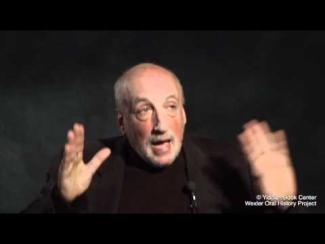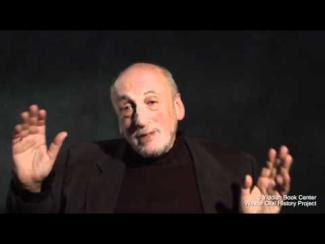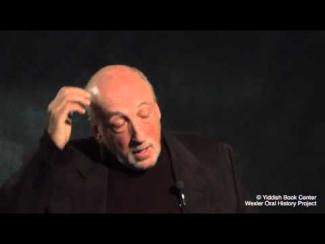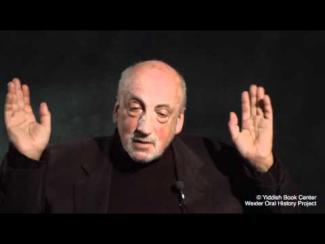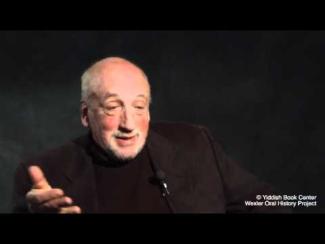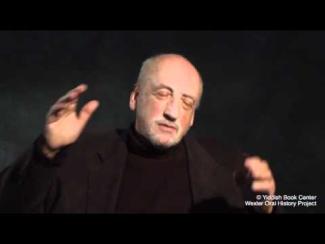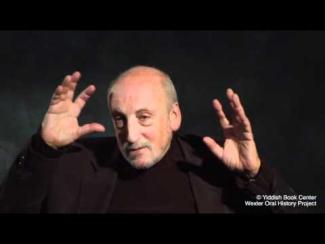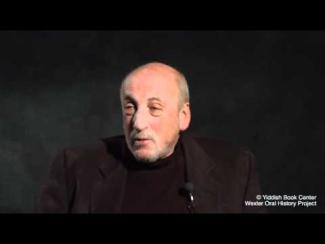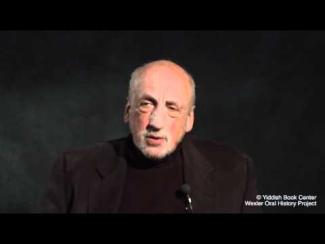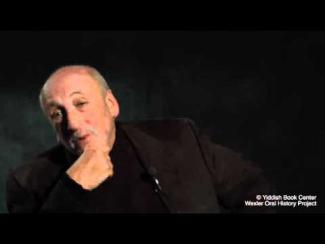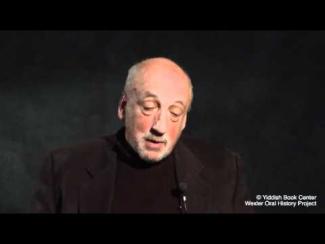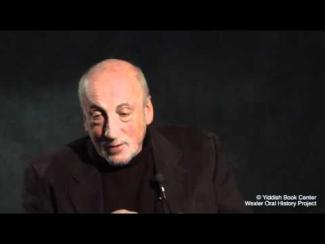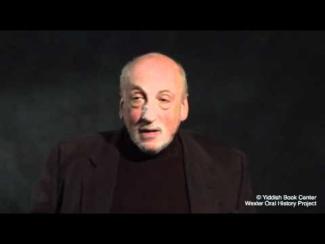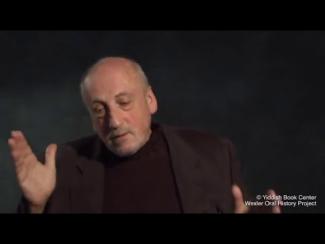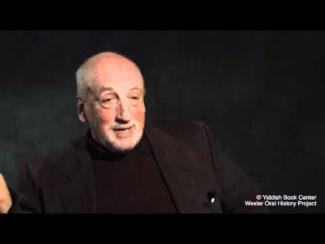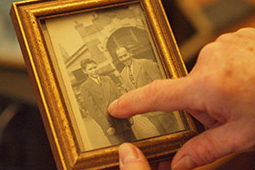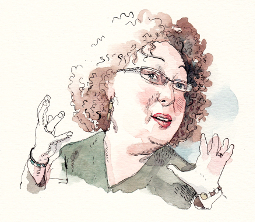The Yiddish Book Center's
Wexler Oral History Project
A growing collection of in-depth interviews with people of all ages and backgrounds, whose stories about the legacy and changing nature of Yiddish language and culture offer a rich and complex chronicle of Jewish identity.
Michael Steinlauf's Oral History
Michael Steinlauf, associate professor of History at Gratz College, was interviewed by Emma Morgenstern on December 19, 2010 at the Association for Jewish Studies Conference in Boston, Massachusetts. Professor Steinlauf is the only child of Polish Holocaust survivors who survived, in hiding, on Polish soil. (Only about 50-70,000 Jews survived on Polish soil.) His parents were both from Warsaw; his mother went to the University of Warsaw and taught history before she went into hiding. His father was in the Warsaw Ghetto through the great deportation, and then went underground. His parents met in liberated Lublin in August 1944 where his father was a founder of the first committee of Jewish survivors on Polish soil. Both had been married before, but after the war they married and went to an Italian displaced persons camp before moving to Paris. Professor Steinlauf was born there and then the family moved to Brighton Beach in New York City when Professor Steinlauf was three years old. Professo Steinlaufâs mother spoke no Yiddish, but his father spoke both Yiddish and Polish. They spoke Polish in the home. Professor Steinlauf remembers Brighton Beach being a Yiddish-speaking, mostly elderly community, with some refugees and their children mixed in. The family did not go to shul (synagogue) except on Yom Kippur; he remembered seeing the Club 21 convert into a shul on that holiday. He went to Hebrew school, which he calls a âtrivial experience.â The home was Jewish simply because his parents were modern Polish-speaking Jews; he emphasized that the Polish part of that identity was important. In fact, he also connected this identity growing up with the time most recently when he found his grandfathersâ tombstones at the major Jewish cemetery in Warsaw. All of Professor Steinlaufâs parentsâ friends were like them: they survived in hiding, lived in Brighton Beach, and had one or two children. These friends used to come over to play Polish card games and rehash war stories; only one friend, Yasha, wouldnât talk because he had survived Auschwitz. Professor Steinlauf left Brighton Beach at 16 to attend Columbia University. He could not wait to leave Brighton Beach because he felt it was too confining. He wanted to be American and was embarrassed by his parents when they wouldnât speak English in public. The tough Jewish kids also beat him up a lot, another reason he wanted to leave. He had already left, in some sense; he attended Stuyvesant High School in Manhattan. Professor Steinlauf remembered, when he was at Columbia, it suddenly dawned on him that the word he was hearing, âHolocaust,â was the same as the word wojna (voyna), which meant war, that his parents and their friends always talked about Every weekend, Professor Steinlauf came home from Columbia to Brighton Beach. But soon he was swept up in the 1960sââThat was my world.â He was involved in the sit-in at Columbia and helped take over buildings. He remembered when Tom Hayden was elected chairman of Math Hall, as well as the arrival of an armed group who called themselves the Motherfuckers of the Lower East Side. The police clubbed students and arrested a thousand of them in one night, including Professor Steinlauf. Now that he knows how many Jews were involved, he thinks of all this as an unconscious way of saying "Never again". Professor Steinlauf mentioned that he did drugs at Columbia as well. He was also involved in a hunger strike and he remembered his parents showing up during it; he told them he was okay so he could get them to leave. Professor Steinlauf earned good grades to get his BA in English at Columbia, and went on to do his Masters in American Literature at the same institution. He felt as if he was being groomed to be an English professor, and early on found a job at Rutgers in Newark. But he found the job intolerable and walked out of the classroom on the first day. He felt there was nothing else to do but make a revolution, so he headed out west, starting in Seattle. Living with a woman there, Professor Steinlauf got involved in radical politics and had friends who founded what some would consider a terrorist group. One of these friends got killed robbing a bank, which spurred Professor Steinlauf to turn away from violence. In Seattle, he was the editor of No Separate Peace, the publication of a community organizing coalition. Professor Steinlauf talked about the mix of Chicanos, Filipinos, Chinese, Native Americans, African Americans and Jews involved in this organization. The Jews had a very specific role, he said: to write the leaflets. Yet he began to see a Jewish diaspora identity parallel to these American minority identities. Professor Steinlauf then moved to Boston, and continued to develop a notion of his own identity as part of a Polish Jewish nation decimated in the Holocaust. He began reading about the Holocaust and then started to study Yiddish. He attended the YIVO program in 1978, where he remembers clashing with a Yiddish teacher over the issue of the Jewish people being alive or dead. He argued that Jews were alive and well, in fact speaking Yiddish still, while the teacher said matter-of-factly, âDos yidishe folk iz nishto.â (The Jewish people are no longer.) From there, Professor Steinlauf went to Poland for a year on a Fulbright Scholarship and made friends with people in the Solidarity movement there. One of Professor Steinlaufâs criticisms of many Yiddishists is that they donât actually go to Eastern Europe to understand the milieu or the physical place of Yiddish. He remembered how the two greatest figures for Polish people at the time were Ronald Reagan and the pope â something not exactly in line with his worldview! Professor Steinlauf enjoys teaching non-Jews and heâs found that teaching allows him to re-discover his own excitement about various topics. Professor Steinlaufâs academic work has revolved around Polish-Jewish relations and Jewish life in Poland before the Holocaust. He also has studied Peretz, who Professor Steinlauf views as an important Jewish diaspora nationalist figure. Yiddish has figured into his academic work because it allows him to access a world thatâs gone. He says he loves Yiddish, and is able to read it well. Professor Steinlauf emphasized his strong links to the âplaceâ that is Poland, and also discussed the interplay between shtetl and urban culture in prewar Poland the a source of a national culture that aspired to modernity. The Jewish Cultural Festival in Krakow, which Professor Steinlauf has participated in, is symbolic of the importance he sees in moving beyond academia to reclaim Jewish culture as oneâs own. Academia is one avenue of learning culture, and itâs better than nothing, but there are other ways, too. In this same vein, cultural dislocations are not a new phenomenon, according to Professor Steinlauf, and sometimes people view culture as a burden even though a Jew in the diaspora does not always have to be a Jew. Professor Steinlauf does not consider himself a Yiddishist, but rather someone who uses Yiddish to open up the past. Although he is uncertain of the future of Yiddish, Professor Steinlauf pointed out that the situation of Yiddish is far superior to that of Hebrew one hundred years ago! The situation has improved recently. He encouraged students of Yiddish to keep at it. Professor Steinlauf mentioned two dichotomies that exist in Yiddish/Jewish contemporary culture: secular and Haredi Yiddish speakers; and Israel vs. Eastern Europe as formational forces in Jewish identity in the modern world.
This interview was conducted in English.
Michael Steinlauf was born in Paris, France in 1947.

